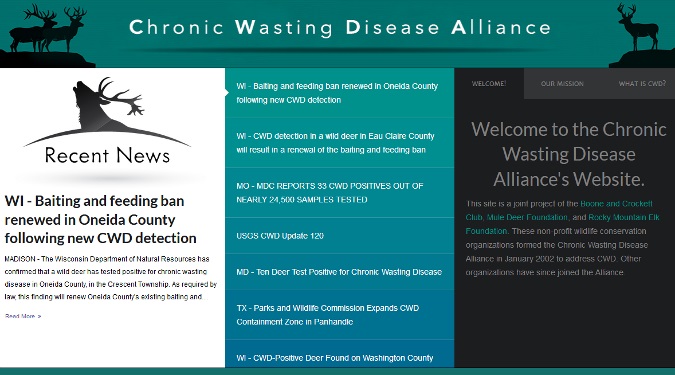
Chronic Wasting Disease (CWD) is a highly contagious, always-fatal disease that affects cervids such as deer, elk, and moose. It is difficult to detect in live animals because there is not a practical test to determine if live animals are infected. Additionally, the outward physical and behavioral signs of CWD often take several years before they are readily observable. There is no vaccine.
Research indicates that CWD can contribute to localized population declines in wild cervid populations and it is spreading, affecting wild populations in more areas in North America. It has been detected in captive and wild populations in about half of the states in the U.S. and several Canadian provinces. Attempts to eradicate the disease have failed, and efforts to control its spread through herd reduction, hunter surveillance, and other methods have had limited success.
Natural and human-caused factors are contributing to the spread of CWD. Infected animals shed disease agents called “prions” that are transmitted to healthy animals through direct contact (saliva) or by encountering shed prions in the environment. Prions are shed when an infected animal feeds, urinates, defecates, or dies and decomposes. These shed prions bind to soil and remain in the environment, capable of infecting healthy animals for several years.
In addition to the spread of CWD through the natural movement of wild animals, there are human-caused factors accelerating the spread of the disease. The leading factor is the transportation of captive deer and elk between breeding facilities and game farms where infected animals come in contact with other captive and wild animals. Transmission of CWD between wild and captive cervids can occur in either direction through fence-line contact and escape of captive animals. Another human-caused factor spreading the disease to new locations is the movement of infected carcasses with improper disposal at the destination. Other practices, such as feeding and baiting, can unnaturally congregate normally scattered elk or deer that increases opportunities for CWD transmission if it is present in a wild population.
State agencies are responding differently to CWD, with some taking aggressive action and some doing very little. Public awareness and participation of hunters vary as well, from denying the existence of the disease to recognizing it as a real problem that must be addressed. As a result, wildlife agencies and other managers are likely to face hurdles when new control strategies impact or conflict with the interests of stakeholders, including sportsmen (e.g., wild herd reductions) and commercial game farms (e.g., depopulation measures and transportation bans).
So far, there is no evidence that CWD is transmissible to humans, nor are there any documented cases of people becoming infected. However, scientists believe the possibility cannot be entirely ruled out, as incubation periods for CWD prions in humans may last for decades and prion diseases in general are capable of developing new strains that can adapt to different species.
As the nation’s oldest hunter-conservationist organization, the Boone and Crockett Club is concerned with wildlife health issues, especially those that can have a negative and widespread effect on game populations. In North America, wildlife conservation is primarily funded by sportsmen in the form of license and tag fees, and excise taxes on sporting arms and ammunition. Conservation funding, and the advocacy for wildlife and their habitats, come primarily from public hunting—one of the cornerstones of our system of wildlife conservation. Without such funding, it will be virtually impossible to conserve our irreplaceable and treasured wildlife resources for the benefit and enjoyment of future generations.
Position
The Boone and Crockett Club maintains CWD is a significant wildlife health problem. CWD has the potential to prevent many populations of wild deer, elk and other cervids from thriving in the long-term. The Club strongly encourages surveillance and management programs to find isolated cases of CWD and remove them from the landscape while few deer are infected. In situations where the disease is widespread, we believe efforts should focus on containment and control strategies.
The scientific community has solved many of the mysteries about CWD biology and ecology, but the knowledge needed to develop effective management and control strategies remains incomplete. How we address diseases among species like cervids that have large, continent-wide distributions is challenging, yet vitally important to the long-term sustainability of these populations. CWD containment is also complicated by the fact it is found in both captive and wild populations that interact and infect one another. The transportation of captive cervids will continue to pose increasing risks to both wild and captive animals in the absence of strict regulations governing such practices.
States, provinces, and tribal lands that are currently CWD-free should consider all available options to prevent it from entering their borders and to detect it if it is present. Another priority should be to obtain more certainty about human exposure risks. Efficacy of various management techniques intended to contain and control the disease should be rigorously evaluated and field-tested.
The Boone and Crockett Club strongly encourages governmental authorities as well as scientists, wildlife management specialists, and stakeholders, to collectively foster and develop sustainable approaches and initiatives to prevent, detect, monitor, control, and contain CWD. The Club will contribute to research, outreach/education, and legislative efforts to reduce infection and transmission rates, fill in knowledge gaps to most effectively manage CWD, stabilize wild cervid populations, and protect people through three primary avenues: The Chronic Wasting Disease Alliance, of which the Club is a founding member,the Club’s William I. Spencer Conservation Grants Program, and the Club’s network of Boone and Crockett Wildlife Conservation Programs located at prestigious universities across the nation.
See also:
